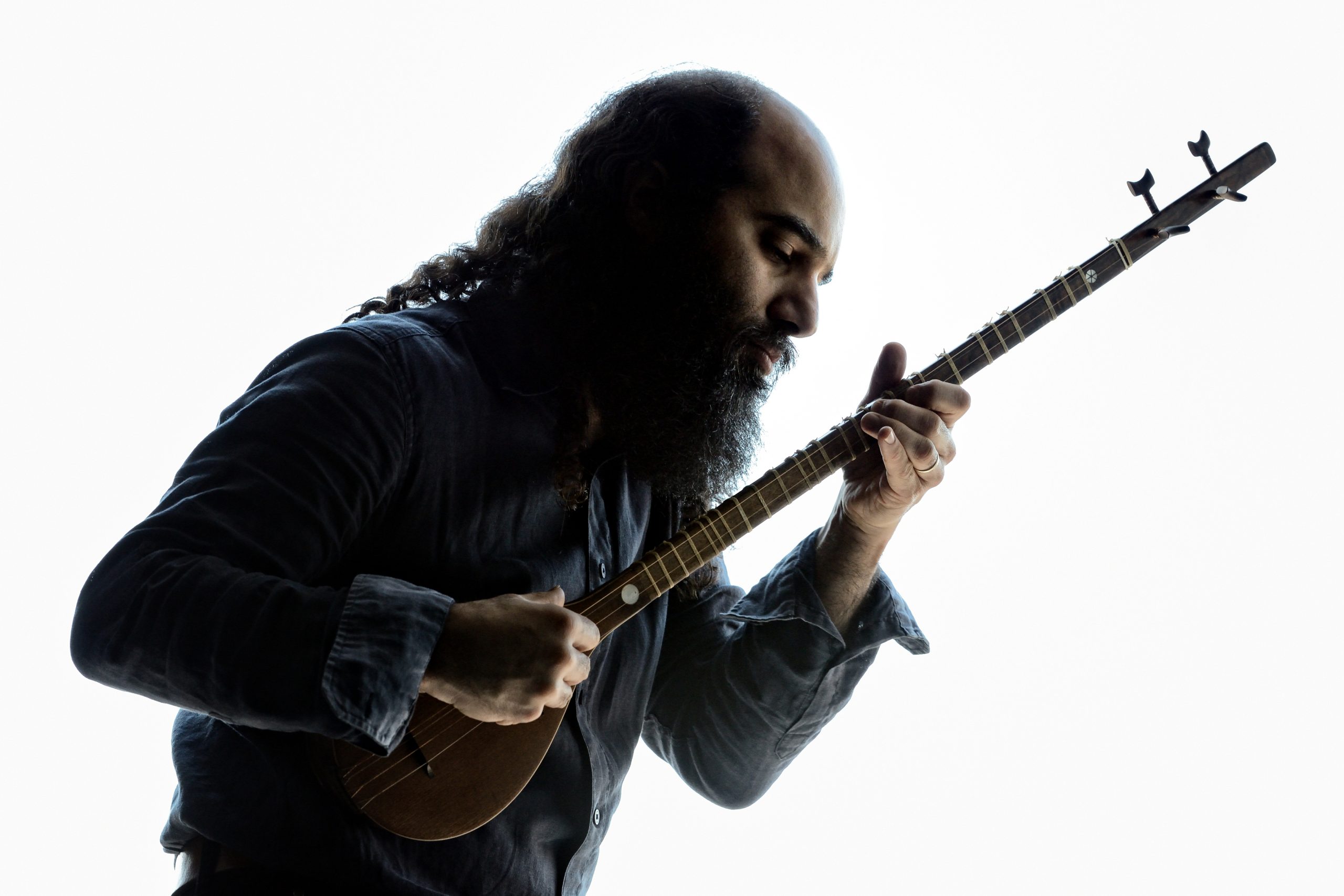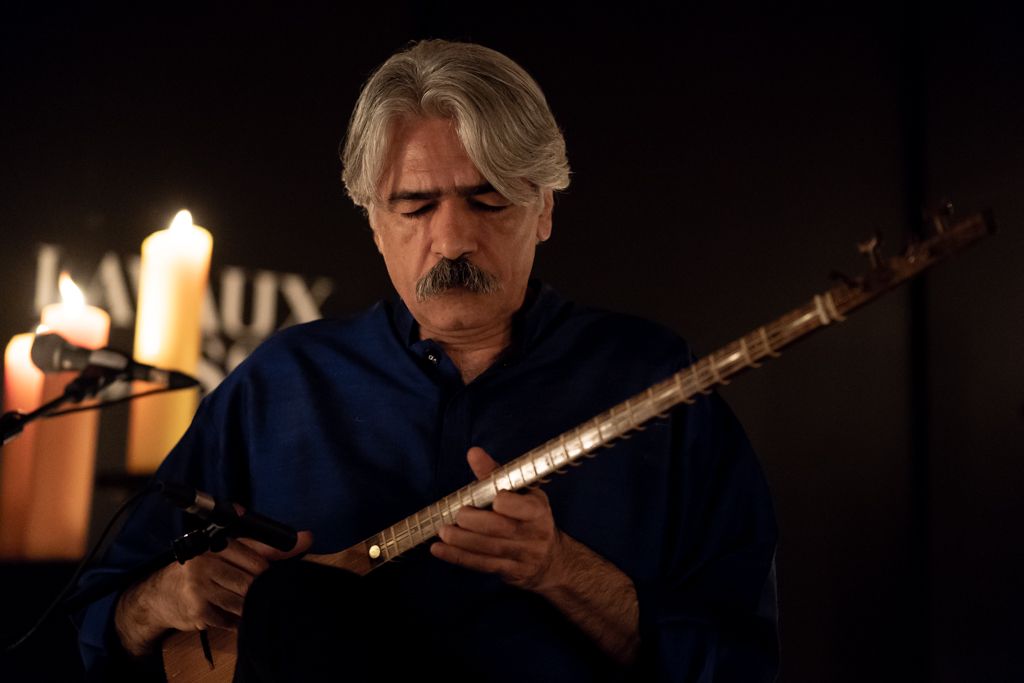This concert will be live streamed on June 3, 2022 at 7:30 p.m. and will be available to watch after 48 hours for two days.
THESE CONCERTS ARE SOLD OUT
From dawn to dusk, music reigns among the stars of Persian civilization. The traditional music of Iran, unique to the Orient, is the fruit of a mystical heritage with a fascinating capacity for constant regeneration. For this unique concert, Kayhan Kalhor, an uncontested master of this tradition, joins Kiya Tabassian on a journey through an immense musical universe. Carrying on tradition while uncovering the future, they make poetry that sings of times both old and new, and contribute to a culture that is in full swing.
The intensely spiritual and emotional improvisations of Kalhor and Tabassian, steeped in the traditional music of Iran, are said to bring listeners to a trance-like state. The ancestry of the setar can be traced to the ancient tanbur of pre-Islamic Persia. It is made from thin mulberry wood and its fingerboard has more than 20 moveable frets. Setar is literally translated as “three strings”; in its present form, however, it has four strings. Because of its delicacy and intimate sonority, the setar is the preferred instrument of Sufi mystics.
” Rather than a duel, the two setarists’ ninety or so uninterrupted minutes onstage turned out to be a clinic in how to build something transcendent.” New York Music Daily
This concert is generously supported by Agnes Hohn.
Programme
This concert is an improvisation, the musicians will introduce their programme from the stage.
About the Setar
Considered the supreme instrument for performing Persian classical music, the setar has a long and rich history.
The instrument can be traced back to the Middle Ages, though it might have even older origins. It is a descendent of the ancient Iranian ‘tambur’, which is credited with being the ancestral form of nearly all lutes now known in the East. The setar underwent many transformations throughout the evolution of Persian music, especially with regard to the instrument’s shape, the number and placement of the frets, and the number of strings. The name setar means ‘three strings’, though a fourth drone string was added in the 18th century by the mystic Moshtaq Ali Shah.
The setar can be tuned in different ways, depending on the mode in which the musician plays. It has between 25 and 29 moveable gut frets that are organized according to the Persian musical scales using microtones. The setar is played with the index finger of the right hand in a back-and-forth movement that allows the musician a variety of combinations as well as ornamentation played by both hands. As the setar is primarily a monodic instrument, the musician usually plays one string at a time.
ONLINE VERSION – PURCHASE TICKETS AND HOW TO WATCH:
Online: Live Streaming by Fee on June 3 at 7:30 p.m. and will be available to watch after 48 hours for two days.
Click here to purchase tickets for the online concert.

Kiya Tabassian, setar
In 1990, at age 14, Kiya Tabassian emigrated with his family to Quebec from his native Iran, bringing with him some initial musical training in Persian music. Determined to become a musician and composer, he continued his education in Persian music, studying with Reza Gassemi and Kayhan Kalhor. At the same time, he studied composition at the Conservatoire de musique de Montréal with Gilles Tremblay. In 1998, he co-founded Constantinople with the idea of developing an ensemble for musical creation that draws from the heritage of the Middle Ages and the Renaissance, of Europe, and of the Mediterranean and the Middle East. Serving as its artistic director, Kiya has developed close to 40 programs with Constantinople. Numerous musical groups and institutions have called upon his talents as a composer, including the Orchestre symphonique de Montréal, the Nouvel Ensemble Moderne and the European Broadcasting Union. He has also composed music for documentary and feature films, including Jabaroot and Voices of the Unheard. Since the summer of 2017, he has held the post of Associate Artist at Rencontres musicales de Conques festival in France. In 2017 he co-founded the Centre des musiciens du monde in Montreal. Kiya also sits on the Board of Conseil des arts et des lettres du Québec.

Kayhan Kalhor, setar
Five-time GRAMMY nominee and a Grammy winner (2017), Kayhan Kalhor is an
internationally acclaimed virtuoso on the kamancheh, who through his many musical
collaborations has been instrumental in popularizing Persian music in the West and is a
creative force in today’s music scene. His performances of traditional Persian music and
multiple collaborations have attracted audiences around the globe. He has studied the
music of Iran’s many regions, in particular those of Khorason and Kordestan, and has
toured the world as a soloist with various ensembles and orchestras including the New
York Philharmonic and the Orchestre National de Lyon. He is co-founder of the
renowned ensembles Dastan, Ghazal: Persian & Indian Improvisations and Masters of
Persian Music.
Kayhan Kalhor has composed works for Iran’s most renowned vocalists Mohammad
Reza Shajarian and Shahram Nazeri and has also performed and recorded with Iran’s
greatest instrumentalists. He has composed music for television and film and was most
recently featured on the soundtrack of Francis Ford Copolla’s Youth Without Youth in a
score that he collaborated on with Osvaldo Golijov. In 2004, Kayhan was invited by
American composer John Adams to give a solo recital at Carnegie Hall as part of his
Perspectives Series and in the same year he appeared on a double bill at Lincoln Center’s
Mostly Mozart Festival, sharing the program with the Festival Orchestra performing the
Mozart Requiem. Kayhan is a founding member of Yo-Yo Ma’s Silk Road Ensemble and
his compositions appear on several of the Ensemble’s albums.


